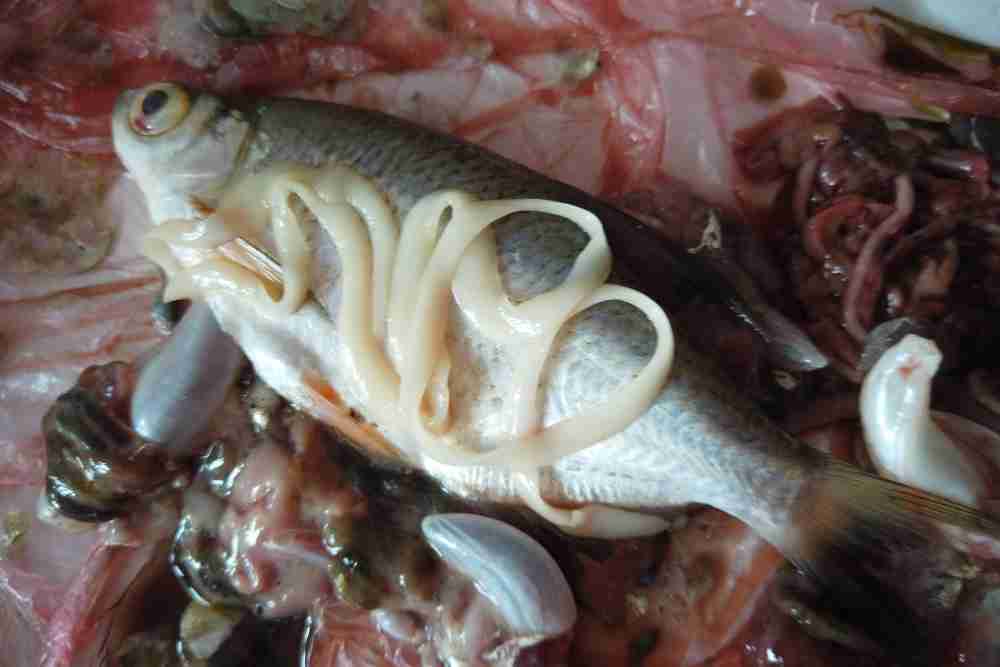Parasitic worms in fish are medically known as helminths and categorized into three broad categories roundworms (nematodes), tapeworms (cestodes), and flukes are parasitic worms.

What is Fish Tapeworm Infection
Tapeworms are parasitic worms that live in the intestines of freshwater fish. They can also live in the intestines of humans and other animals.
Tapeworms are very small (about 1/4 inch long) and can grow several feet long. They can stay many years in the host intestine.
They vary in size from barely visible to several feet long. Among parasites, nematode (Anisakis spp., Pseudoterranova spp., Eustrongylides spp. and Gnathostoma spp.), cestode (Diphyllobothrium spp.) and trematode or fluke (Chlonorchis Sinensis, Opisthorchis spp., Heterophyes spp., Metagonimus spp., Nanophyetes salminicola, and Paragonimus spp.) infections in seafood are of greatest concern.
Most tapeworms live in the fish intestine. Diphyllobothrium sp. is an example of a broad tapeworm.
The aquatic life cycle of tapeworm is completed when the adult parasite eggs are released into the environment, where they will hatch and grow into new tapeworms.
Transmission of Fish Tapeworms
There are many ways that a fish tapeworm can enter the body of a fish, but the most common way is through ingestion of eggs or larvae that another fish has excreted.
Fish tapeworms can also be spread through fecal matter, contact with contaminated water, or when an infected fish is killed and its flesh eaten by another fish.
Transmission can begin from undercooked meat and raw fish. In undercooked beef, pork, or fish, a tapeworm egg can survive stomach acids and develop into larvae.
The life cycle of a typical tapeworm starts with an egg that is excreted in the feces of an infected fish.
The egg will then hatch into a larva that will travel through the water until it finds a suitable host.
Once it finds a host, the larva will attach itself to the intestinal wall and grow into an adult tapeworm.
Mammals or birds can eat infected fish. The eggs hatch in freshwater, and the crustaceans swallow the eggs. Fishes then eat the crustaceans and become infected.
Read Related Article: Roundworms In Fish (Biology, Causes & Treatment)
Read Related Article: Flukes In Fish (Causes, Symptoms & Treatment)
Life Cycle of Fish Tapeworms
The life cycle of the broad fish tapeworm has more than one host. Eggs that have been passed through the aerobiosis are placed in animal excrement. Under proper circumstances, the eggs mature (approximately 18 to 20 days) and yield a cirripede known as a coracidia. After ingestion by a suitable crustacean (first intermediate host), the coracidia develop into procercoid larvae.
Freshwater fish eat copepods and larvae that enter the body through the digestive tract and develop into a second-stage larva that remains meters.
The first larval stage (Procercoid larvae) is released from the crustacean upon predation by the second intermediate host.
However, a small second intermediate copepod host can be eaten by larger predator species that serve as definitive host species.
When this happens, the second larval stage (plerocercoid) migrates to the musculature of the larger predator fish; humans and other definitive host species acquire the parasite via eating undercooked definitive host fish.
The adults can reach more than 10 m in length; 3,000 proglottids release the eggs; the eggs then spread in the feces 5 to 6 weeks after the infection begins.
Immature eggs are discharged from the proglottids (up to 1 million eggs per day per worm) and subsequently passed through the feces. Tapeworm cysts sometimes burst, releasing more tapeworms, which can spread to organs and form additional cystic masses.
Signs and Symptoms of Tapeworm Infection in Fish
When a fish becomes infected with a tapeworm, it may exhibit changes in behavior or appearance.
In some cases, the fish may die from an undetermined cause.
When a fish contracts the tapeworm infection, tapeworm larvae are present internally in its muscle tissue.
Adult worms attach to the wall of the intestinal mucosa. Massive infections can cause intestinal blockages.
Diagnosis of Fish Flatworms
Fish Tapeworm Treatment
Read Related Article: Ich on Fish: Causes, Symptoms & Treatment
Read Related Article: Anchor Worms In Fish: Causes, Signs & Treatment
Prevention of Tapeworm in Fish
Tapeworms are larvae of parasitic flatworms found in carp, goldfish, koi, and many other types of fish.
The larvae live in the intestine of the fish, and when they mature, they exit through the anus and attach to other animals, including people.
Prevention of parasitic infection in fish is important, as this type of parasite can cause serious problems for both the animal and humans that consume them.
Several steps can be taken to protect fish from tapeworms, including keeping them clean and healthy, ensuring a clean environment, and preventing them from ingesting contaminated food or water.
Fish tanks should contain clean water and avoid overfeeding to control good water quality. Dirty water needs to be replaced by fresh water.
Read Related Article: Fish Lice: Causes, Symptoms & Treatment
Final Words
In conclusion, tapeworm infection in fish is a serious problem that can cause significant health problems in both fish and humans. It is important to take steps to prevent and treat this infection, as it can be deadly if left untreated.
3 thoughts on “Fish Tapeworm (Biology, Causes & Treatment”
Comments are closed.